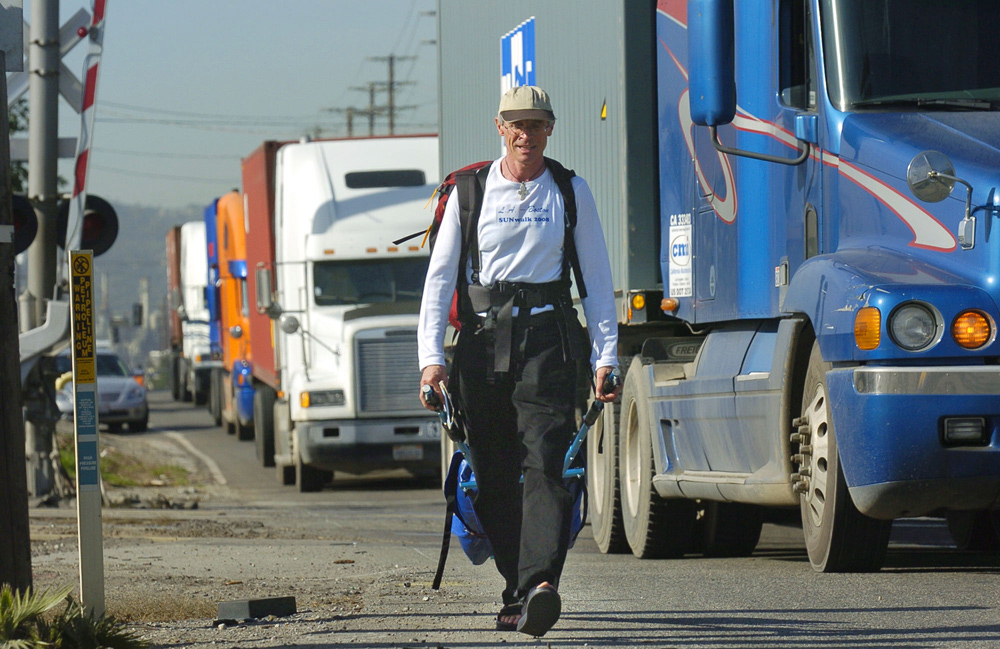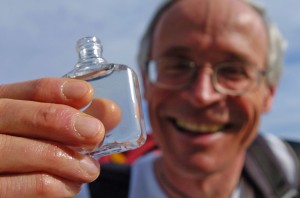NOTHING LIKE THE SUN
Last year Martin Vosseler and a crew of four other Swiss adventurers made a historic crossing of the Atlantic aboard Sun21—a solar powered catamaran. This year Vosseler, a doctor by vocation, decided to take his message of solar power and energy renewal—on foot. Since January (2008) he has been walking across the United States. Helvetica Bold caught up with the itinerant doctor by phone when spent the night with friends in Beebe, Arizona:
In a nutshell, what is SUNwalk about?
I’m a medical doctor and as a doctor you develop a sense for priorities—for instance if you have a life threatening situation like arterial bleeding there is just one thing you should do and that is to stop this bleeding hundred percent, and for me the climate change, with all its consequences is for me a similar situation on a global level. I see a number one priority in changing our whole energy system from oil, gas, coal and nuclear energy to one hundred percent efficient and renewable energy. And that’s what I walk for.
Why not walk though Europe?
I did! I walked from Basel, Switzerland to Jerusalem—a six month walk —again the same issue, the motto: there is enough sun for all of us! And here it’s a very good pre-condition because if people see me walking with my cart with my sun flag, they ask themselves: “What is that all about?” “Is that a homeless guy?” And thousands of people see me—I wave to them, they wave back (nine out of ten wave back)–and then they read in the newspaper or they see a TV show—why I walk—that is then a good way to spread the message. If they connect with this encounter, if they read about it or see a show about it.
The reason I walk in the United States is because I believe very much in the innovative potential of this country and I’m convinced that the United States has to become a leader in this clean energy revolution. This whole change is huge economic potential a big potential for world economy— a lot of good jobs will be created. Also, walking is very healthy—it’s fantastic to combine energy saving with walking—for me traveling by foot is the most intensive way of traveling—you meet so many helpful people, you come through wonderful landscapes you learn everyday something new about nature, about history, culture. These four reasons make it imperative for me to walk through the United States for me.
So one of the aims of this is to be visible—how did you pick your route? Are you walking on highways, do you take the scenic route—do you go on trails?
I choose highways—sometimes even a freeway. I’ve walked several times on the I-40, then I walked on Route 66 quite a while in California and Arizona and now in Texas route 60—these are smaller highways where it’s quite safe to walk, but all the same, a lot of traffic—I get a lot of encounters with people.
What happens during your day?
In the morning breakfast is very important–it’s a big part of the fueling. I have always a good breakfast and then I walk for a while—at noon I go to the restaurant on the way in a village or a little town—and so far, very few people have walked with me, a friend of mine from Switzerland, Andreas Hoffman — he’s a professor of cardiology—walked with me in Oklahoma, and there was a friend from Monrovia who helped me to cross the Mojave desert. Then there are some people who walk maybe one or two blocks with me or a thousand steps—and there are animals who walk with me—
What sort of animals?
Horses are so excited if they see somebody who is not in a car—they run in a circle, then they walk along the fence, also cows—I have all sorts of encounters with animals, they respond very well to my SUNwalk.
The idea of walking—especially through the desert reminds me of the Australian aboriginal walkabout ritual for young men, which is an exercise in shamanism. Is there a mystical element to your walking?
Certainly yes! For me walking is like a prayer—with my whole body, my whole soul: you know every step is getting in touch with our Mother Earth; with this fantastic planet; this unique oasis in the universe…
We have an amazing concentration of miracles that make life possible. For me, after three, four weeks of walking I get a sense of this fantastic perfect ball we are living on–you feel the curved shape of the earth, you know the horizon—the back goes away, new hills come up—so you get this sense of walking on this fantastic planet and a deep gratitude for the life conditions that we have and also a big motivation to do something to keep this planet inhabitable and to stabilize these life conditions.
Interesting, your sentiments echo those of astronauts floating in space who look down at the planet from a certain height and are suddenly overcome with a surge of love and compassion for the Earth which they now perceive as one beautiful blue breathing entity… It’s called the “Astronaut Effect”—except you seem to be doing it from the ground—
As a Swiss man, its so unique to walk through this huge space—in Switzerland we have a beautiful variety of landscape in a very small territory—but here, you are in this enormous space—the high desert of New Mexico; the flat areas of Texas; these rolling hills of Oklahoma, and always this big sky above you… You really get a sense of the vastness and the biodiversity of this planet.
Have there been times (especially walking in the desert) when the earth was not such a welcoming habitat?
For me in the desert the conditions were sometimes quite rough—I had snowstorms in Hopi Land in Navajo country. It was cold—but on the other hand, you felt carried and nurtured by the people that are helpful. So for me it was never really an extreme situation—maybe once or twice when I had to camp in the snowstorms and I couldn’t get my hands warm during the day because of wet and cold climate—that was the toughest part. Other than that I feel nurtured by nature when I am connected with it.
What were your experiences with Native Americans like?
I was very touched when I walked through these territories—there was so much giving and taking—back and forth. You know, people stopped, they asked why I walked, they offered me drinks, sandwiches… They read in the Navajo Times in Window Rock about my walk and that helped so much to get in touch with the population. It was a very intense time with the Native American people and I was privileged enough to be able to attend one of the Bean Dances of the Hopi people—thanks to a connection with a Hopi friend, Debbie Tewa who works for the state of Arizona. She is as an electrician who wants to bring solar energy to the Hopi villages and she came twice to Switzerland to lecture about it at our international Sun21 conference.
You’ve been walking four months already, have there been any striking experiences?
It’s hard to say, it’s like a galaxy for me—a galaxy where the stars are encounters with helpful people, hospitable people. Yesterday for instance, a guy runs out of a store and brings me a bottle of water—he doesn’t know who I am but he just wanted to support me and he asked where I was walking to and I told him — he was like “Are you #%$*king serious?” And so there are many of these short beautiful encounters: people who don’t charge me in a restaurant (they say “For somebody who walks, we don’t charge here…”); Or people who offer me rides, you know I could have accepted five hundred rides so far at least. I always tell them that it warms my heart and gives me energy and I will walk 100 percent from Los Angeles to Boston. So these encounters are the striking experience.
Another one is the power of nature: already when I crossed the Atlantic on a container boat, we had heavy storms—six in a row. And then a snowstorm at the Grand Canyon—that was grandiose—the wind combed these ponderosa pines for hours. It was so powerful and then when it was over, the beauty of the Grand Canyon in the snow, the clear sky and the sun—these are things I will never forget.
Is it true that you haven’t taken an airplane in 13 years?
Actually the last plane was not so long ago—in 2001 I took a plane—I took a boat ride to the United States but then I flew back. But before that the last plane was in 1989.
Do we have to scale back on the luxury of speed to repair this planet—or do you think we can hit on ways while maintaining the same pace of life with renewable energy?
What I am becoming aware of is that I do more with my own muscles—it’s so much more gratifying–I have so many more sensual beautiful experiences when I walk. I have a much better body feeling, really after three months of walking you are in pretty good shape, I must tell you. So no, it’s not a renouncement, rather it’s gaining something!
My quality of life improved so much since I no longer drive a car—or since I stopped flying. It just gets enters another dimension which is a healthier with much more intense experiences. When I compare my trips with planes in the 70s— you know to the Seychelles and so on—in comparison with walking through Europe or now, through the United States, there is such a wealth of good experiences and encounters.
It’s a change of lifestyle and I was very happy for example in Window Rock— when a cashier in a supermarket said “Ah you are the guy who walks! Here is the newspaper, please autograph it!” and then she said “You know, I read that and told myself if this guy who is almost 60 walks from LA to Boston— I can also walk from my home to the supermarket! And this morning, I walked for the first time and actually I liked it.”
These are changes that can happen and then you realize that you may lose something, but you gain so much more.
If you had one message for the next generation (or anyone who cares to listen), what would if be?
Discover what makes you excited, discover where your enthusiasm is and try to combine that enthusiasm with your own body’s activities—with your body joy, with feeling your body, feeling your movement, feeling your dance of life and then you realize little by little what is healthy for us is also healthy for our planet.





